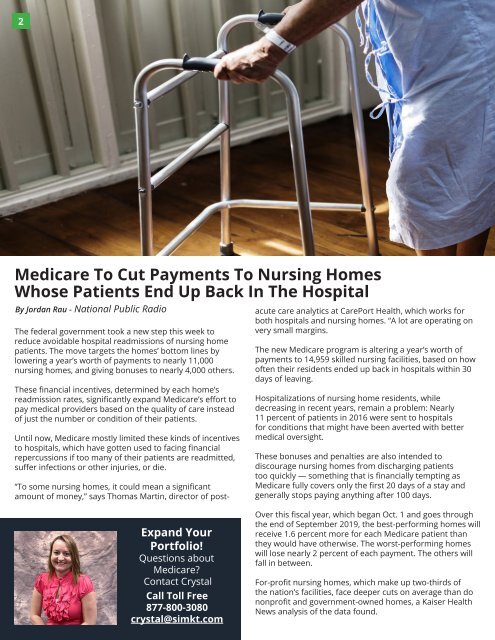sim-newsletter-December-18-web
You also want an ePaper? Increase the reach of your titles
YUMPU automatically turns print PDFs into web optimized ePapers that Google loves.
2 3<br />
Continued fron Page 1<br />
2019 Forecast...<br />
1. Addressing Student Loans: Student loan debt continues to<br />
reach record highs and it even exceeds credit card debt and<br />
auto loan debt. More than one-third of employees overall<br />
(and 55% of millennials) said student loan repayment is a<br />
must-have benefit, according to a Unum study. With only 4<br />
percent of employers currently offering employees some<br />
form of assistance to repay student loans, 2019 is going to see<br />
employers and the industry itself finding ways to offer student<br />
loan refinancing and repayment benefits.<br />
Medicare To Cut Payments To Nursing Homes<br />
Whose Patients End Up Back In The Hospital<br />
By Jordan Rau - National Public Radio<br />
The federal government took a new step this week to<br />
reduce avoidable hospital readmissions of nursing home<br />
patients. The move targets the homes’ bottom lines by<br />
lowering a year’s worth of payments to nearly 11,000<br />
nursing homes, and giving bonuses to nearly 4,000 others.<br />
These financial incentives, determined by each home’s<br />
readmission rates, significantly expand Medicare’s effort to<br />
pay medical providers based on the quality of care instead<br />
of just the number or condition of their patients.<br />
Until now, Medicare mostly limited these kinds of incentives<br />
to hospitals, which have gotten used to facing financial<br />
repercussions if too many of their patients are readmitted,<br />
suffer infections or other injuries, or die.<br />
Expand Your<br />
Portfolio!<br />
Questions about<br />
Medicare?<br />
Contact Crystal<br />
Call Toll Free<br />
877-800-3080<br />
crystal@<strong>sim</strong>kt.com<br />
“To some nursing homes, it could mean a significant<br />
amount of money,” says Thomas Martin, director of postacute<br />
care analytics at CarePort Health, which works for<br />
both hospitals and nursing homes. “A lot are operating on<br />
very small margins.<br />
The new Medicare program is altering a year’s worth of<br />
payments to 14,959 skilled nursing facilities, based on how<br />
often their residents ended up back in hospitals within 30<br />
days of leaving.<br />
Hospitalizations of nursing home residents, while<br />
decreasing in recent years, remain a problem: Nearly<br />
11 percent of patients in 2016 were sent to hospitals<br />
for conditions that might have been averted with better<br />
medical oversight.<br />
These bonuses and penalties are also intended to<br />
discourage nursing homes from discharging patients<br />
too quickly — something that is financially tempting as<br />
Medicare fully covers only the first 20 days of a stay and<br />
generally stops paying anything after 100 days.<br />
Over this fiscal year, which began Oct. 1 and goes through<br />
the end of September 2019, the best-performing homes will<br />
receive 1.6 percent more for each Medicare patient than<br />
they would have otherwise. The worst-performing homes<br />
will lose nearly 2 percent of each payment. The others will<br />
fall in between.<br />
For-profit nursing homes, which make up two-thirds of<br />
the nation’s facilities, face deeper cuts on average than do<br />
nonprofit and government-owned homes, a Kaiser Health<br />
News analysis of the data found.<br />
In Arkansas, Louisiana and Mississippi, 85 percent of<br />
homes will lose money, the analysis found. More than<br />
half in Alaska, Hawaii and Washington state will get<br />
bonuses.<br />
Overall, 10,976 nursing homes will be penalized, 3,983<br />
will get bonuses and the remainder will not experience<br />
any change in payment, the KHN analysis found.<br />
Medicare is reducing payments to 12 of the 15 nursing<br />
homes run by Otterbein SeniorLife, an Ohio faithbased<br />
nonprofit. Pamela Richmond, Otterbein’s chief<br />
strategy officer, says most of its readmissions occurred<br />
with patients after they went home, not while they<br />
were in the nursing facilities. Otterbein anticipates<br />
losing $99,000 over the year.<br />
“We’re superdisappointed,” Richmond says about the<br />
penalties. She says Otterbein has started to follow up<br />
with former patients or with the home health agencies<br />
that send nurses and aides to patients’ houses to care<br />
for them. If there are signs of trouble, Otterbein will try<br />
to arrange care or bring patients back to the nursing<br />
home if necessary.<br />
“This really puts the emphasis on us to go out and<br />
coordinate better care after they leave,” Richmond<br />
says.<br />
Congress created the Skilled Nursing Facility Value-<br />
Based Purchasing Program incentives in the 2014<br />
Protecting Access to Medicare Act. In assigning<br />
bonuses and penalties, Medicare judged each facility’s<br />
performances in two ways: how its hospitalization rates<br />
in calendar year 2017 compared with other facilities<br />
and how much those rates<br />
changed from calendar...<br />
Click to Read More ><br />
2. Taking Care of the Caregivers: Next year will see employers<br />
being more comprehensive with benefits that address<br />
the needs of employees who serve as caregivers. Today’s<br />
multigenerational workforce includes employees who care<br />
for parents, adult children and even grandchildren on a<br />
variety of levels -- emotionally, financially and with general<br />
caregiving support. In fact, nearly one in four employees is<br />
providing financial support for parents or in-laws; and among<br />
employees with adult children, 42 percent are providing<br />
financial support to them, according to the PwC study. Elder<br />
care support, childcare, adoption assistance, financial wellness<br />
benefits -- all are increasingly important to the caregivers.<br />
3. Facilitating Savings: The statistics are staggering --<br />
employees are still struggling paycheck-to-paycheck; many<br />
don’t have $1,000 or more in savings to use for emergencies;<br />
and the typical worker has saved $0 for retirement. It’s time<br />
for the industry to help employees start to take control of<br />
their financial future by encouraging savings. Look for more<br />
financial services benefits in 2019 that offer automated<br />
savings plans as a voluntary benefit.<br />
4. Encouraging Utilization of Financial Wellness Benefits:<br />
Financial wellness has been the buzz for a couple of years now<br />
and employers have added a variety of financial wellness and<br />
education voluntary benefits. But only one-third of employees<br />
utilize the financial wellness benefits their employer offers,<br />
according to the 20<strong>18</strong> Workplace Benefits Report from Bank<br />
of America Merrill Lynch. It’s a <strong>sim</strong>ple fact that when financial<br />
wellness benefits aren’t used, they don’t work. Employers and<br />
the industry alike will be searching for ways to make these<br />
benefits more engaging, personalized and effective in order to<br />
help their employees improve their financial wellness.<br />
5. Communicating Year-Round: With so many benefit<br />
offerings available today, it can be mind-boggling to<br />
employees to be aware of them all and to understand them.<br />
Year-round benefits communications in a multitude of<br />
communication methods that appeal to each generation and<br />
on platforms and devices they pay attention to is mandatory.<br />
2019 will see employers and the industry re-dedicate itself to<br />
benefits communications, understanding and engagement.<br />
Click for Full Article<br />
Call 877-800-3080 Today to Learn More!




